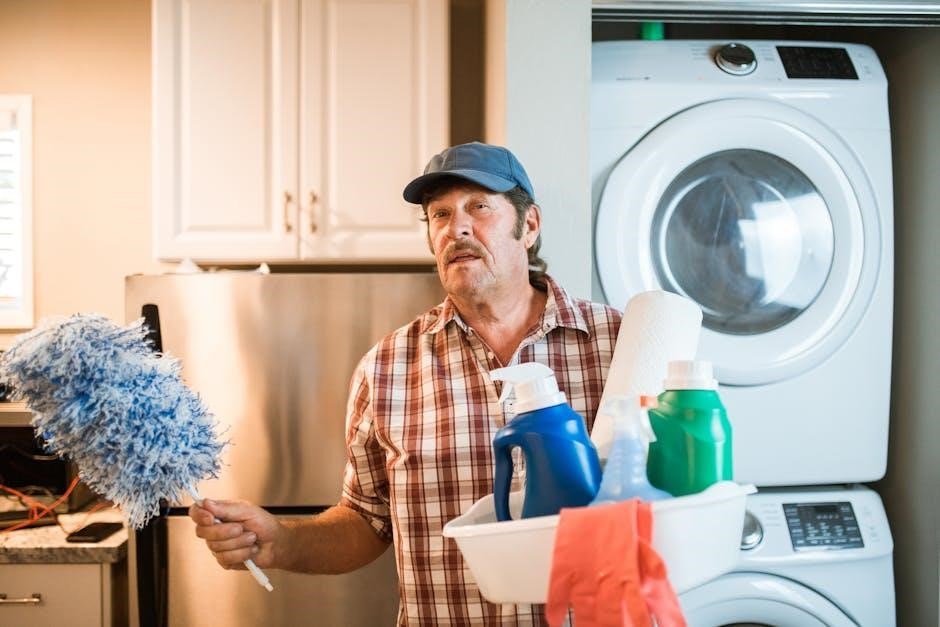GE Washer Dryer Combo Error Codes: A Comprehensive Guide
This guide offers a detailed overview of GE washer dryer combo error codes, providing the knowledge to address common issues. It covers troubleshooting, resets, diagnostics, maintenance, and optimal performance for your appliance.
GE washer dryer combos utilize error codes as a communication method for various malfunctions. These codes, displayed on the control panel, offer valuable clues for troubleshooting, making understanding them crucial for efficient problem-solving. The codes are often alphanumeric, combining numbers and letters (e.g., F01, LE), with each code corresponding to a specific issue.
These issues range from simple problems, such as an unlatched door, to more complex mechanical failures. Accessing a detailed error code list, either through your appliance’s manual or online resources, is essential for proper interpretation. These resources typically offer descriptions of each code and suggest initial troubleshooting steps that you can take.
Knowing the meaning of these codes allows you to avoid unnecessary service calls and potentially save on repair costs. Properly interpreting these codes is the first step in effectively addressing problems with your GE washer dryer combo, so prioritize safety and consult expert advice when unsure.
Understanding the Importance of Error Code Interpretation
Error code interpretation is paramount when addressing issues with your GE washer dryer combo. These codes serve as the appliance’s way of communicating specific problems, offering insights into the nature and location of the fault. Accurate interpretation allows for targeted troubleshooting, preventing unnecessary repairs and costs. Ignoring or misinterpreting these codes can lead to wasted time and resources.
A correct understanding enables you to differentiate between minor issues that can be resolved at home and more complex problems requiring professional intervention. This knowledge empowers you to make informed decisions about whether to attempt a DIY fix or seek expert assistance, ultimately saving you money and minimizing downtime.
Moreover, proper interpretation ensures that any necessary repairs are focused and effective. By pinpointing the root cause of the problem, you can avoid replacing unnecessary components and ensure that the correct part is addressed. This leads to a more efficient and cost-effective repair process, prolonging the life of your appliance.
Common GE Washer Dryer Combo Error Codes
Several error codes frequently appear on GE washer dryer combos, signaling common malfunctions. One prominent code relates to the lid lock mechanism, often indicating an improperly closed lid or a faulty locking system. This code typically prevents the wash cycle from initiating.
Water level sensor errors are another common occurrence, suggesting issues with the appliance’s ability to detect the correct water level. These errors can result in either insufficient or excessive water during the wash cycle, impacting cleaning performance.
Locked rotor errors also frequently arise, indicating that the motor is jammed or experiencing excessive resistance. This prevents the drum from spinning properly and can be caused by unbalanced loads or foreign objects obstructing the motor.
Finally, pressure sensor errors can occur, signaling difficulties in the system’s ability to monitor water pressure. This affects filling and draining processes, leading to inefficient operation. Recognizing these common codes is crucial for prompt troubleshooting.
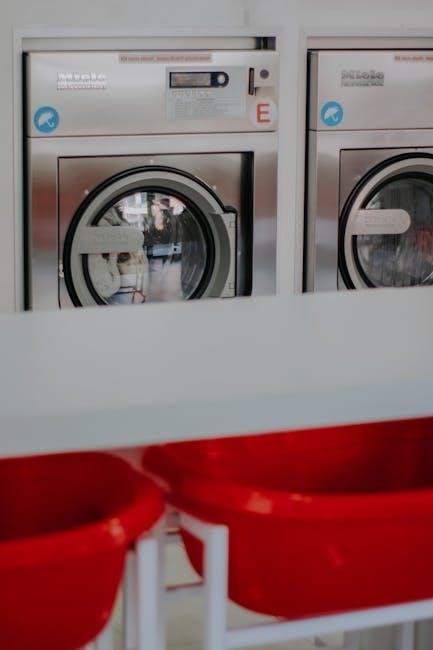
Lid Lock Error

The Lid Lock Error, often indicated by a code like “Lid” or a number associated with door issues, signifies a problem with the washer dryer combo’s lid locking mechanism. This error typically arises when the lid isn’t fully closed or the locking mechanism malfunctions, preventing the machine from starting its cycle.
Several factors can trigger this error. Obstructions preventing proper lid closure, such as clothing or debris caught in the latch, are common culprits. A faulty lid switch, responsible for detecting lid closure, can also cause this error.
Furthermore, a damaged or malfunctioning locking mechanism itself might be the source of the problem. When this error appears, prioritize checking for obstructions and ensuring the lid is securely closed. If the issue persists, a closer inspection of the lid switch and locking mechanism is necessary to identify any potential damage or malfunctions.
Water Level Sensor Errors
Water Level Sensor Errors, often displayed with codes like “Water Level,” “Level Sensor,” or alphanumeric combinations like “1E,” indicate issues with the washer dryer combo’s water level sensing system. These errors suggest that the machine is unable to accurately detect the water level during the filling process.
This can result in either insufficient water filling, leading to ineffective washing, or excessive water filling, potentially causing overflows. Several factors can contribute to these errors. A malfunctioning water level sensor itself, which is responsible for measuring the water level, is a primary suspect.
Additionally, blockages or kinks in the hoses connected to the sensor can disrupt accurate readings. Low water pressure in the supply lines can also interfere with the sensor’s ability to detect the correct water level. Inspecting the sensor, hoses, and water pressure is crucial for troubleshooting these errors.
Locked Rotor Error
A Locked Rotor Error, often indicated by codes like “Locked Rotor,” “Rotor Error,” or numerical codes like “3,” signifies a problem with the motor’s ability to rotate freely. This error typically arises when the motor encounters excessive resistance or becomes physically jammed, preventing it from spinning as intended.
Several factors can contribute to a locked rotor. An unbalanced load within the drum is a common cause, as the uneven distribution of weight places undue stress on the motor. Foreign objects lodged within the drum, such as clothing items or small objects, can also obstruct the motor’s rotation.
In more severe cases, a motor component failure, such as a seized bearing or a damaged winding, can lead to a locked rotor. When encountering this error, it is crucial to immediately stop the machine and investigate the potential causes. Attempting to force the motor to run in a locked state can cause further damage to the motor and other components.
Pressure Sensor Errors
Pressure Sensor Errors, sometimes displayed as codes like “Pressure Error,” “PS Error,” or numerical codes such as “8,” indicate issues with the system’s ability to accurately monitor water pressure. These sensors are vital for regulating the filling and draining processes of the washer dryer combo, ensuring correct water levels during each cycle.
Several factors can cause pressure sensor malfunctions. A faulty pressure sensor itself is a common culprit, as the sensor may become damaged or lose its calibration over time. Clogged or kinked pressure lines connecting the sensor to the water system can also disrupt pressure readings.
Malfunctioning pumps, which are responsible for circulating water throughout the machine, can also lead to inaccurate pressure readings. When a pressure sensor error occurs, the washer dryer combo may exhibit problems with filling, draining, or maintaining the correct water level during the wash cycle.
These errors can impact the efficiency of the wash cycle and potentially damage the appliance if left unaddressed.
Basic Troubleshooting Steps for Common Errors
Before seeking professional assistance for your GE washer dryer combo, attempting basic troubleshooting steps can often resolve common error codes. These steps involve simple checks and procedures that can help identify and address minor issues without requiring specialized tools or expertise. Safety should always be the priority; disconnect the power supply before performing any internal inspections or repairs.
Start by consulting your appliance’s user manual for model-specific troubleshooting guidance. The manual provides valuable information on error code meanings and recommended solutions. Inspect the power cord and ensure the unit is properly plugged into a functioning electrical outlet.
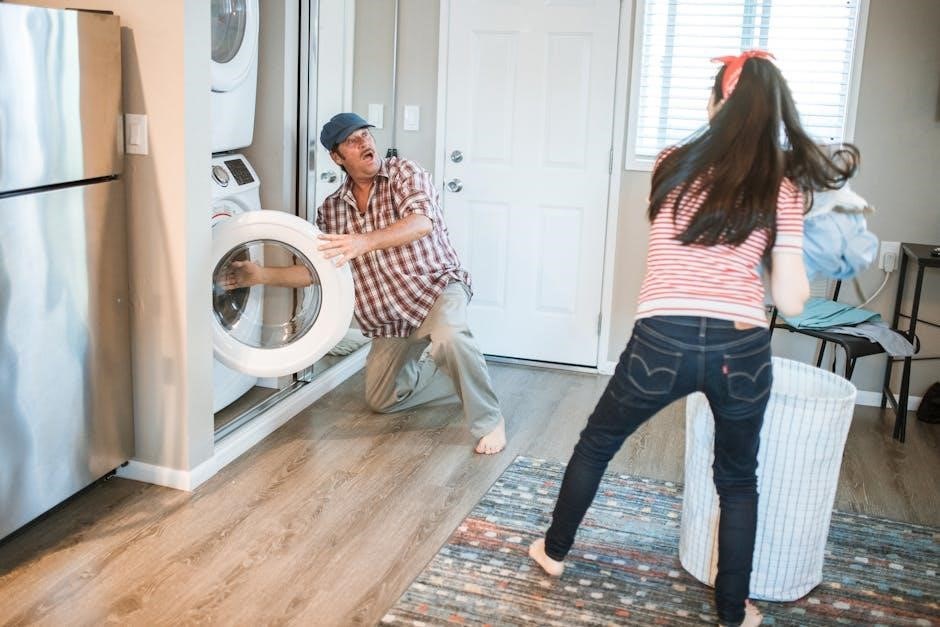
Check the water supply lines for kinks, blockages, or insufficient water pressure. Verify that the drain hose is not clogged or obstructed, as this can affect water drainage and trigger error codes. Ensure the washer dryer combo is level, as an unbalanced machine can cause vibrations and potential damage.
By following these basic troubleshooting steps, you can often resolve common error codes and restore your GE washer dryer combo to optimal performance.
Troubleshooting Lid Lock Errors
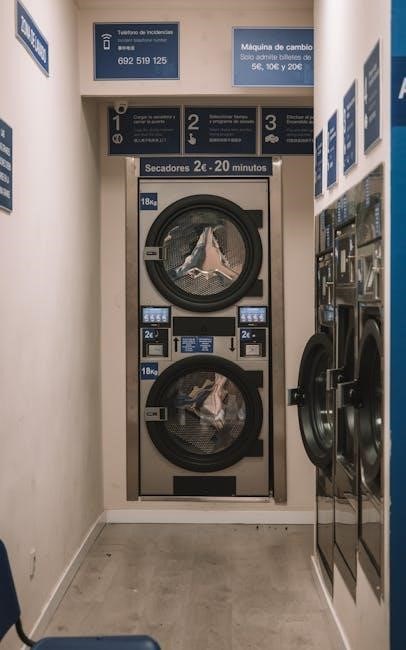
A Lid Lock Error on your GE washer dryer combo typically indicates that the lid is not properly closed or that the locking mechanism is malfunctioning. This error usually prevents the wash cycle from starting. First, ensure that the lid is securely closed and that there are no obstructions preventing it from latching properly.
Inspect the lid switch, which is a small component that detects whether the lid is closed. Make sure it is not damaged or misaligned. If the lid switch appears to be faulty, it may need to be replaced. Check for any foreign objects or debris that may be interfering with the lid locking mechanism.
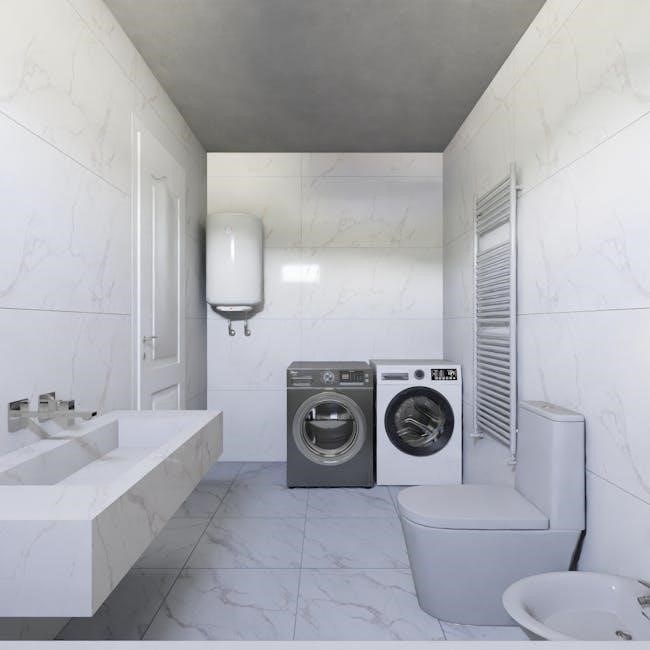
Sometimes, a simple reset can resolve a Lid Lock Error. Unplug the washer dryer combo from the power outlet for a few minutes, then plug it back in. This can sometimes clear temporary software glitches that may be causing the error. If the problem persists after these steps, the lid locking mechanism itself may be faulty and require professional repair or replacement.
Addressing Water Level Sensor Errors
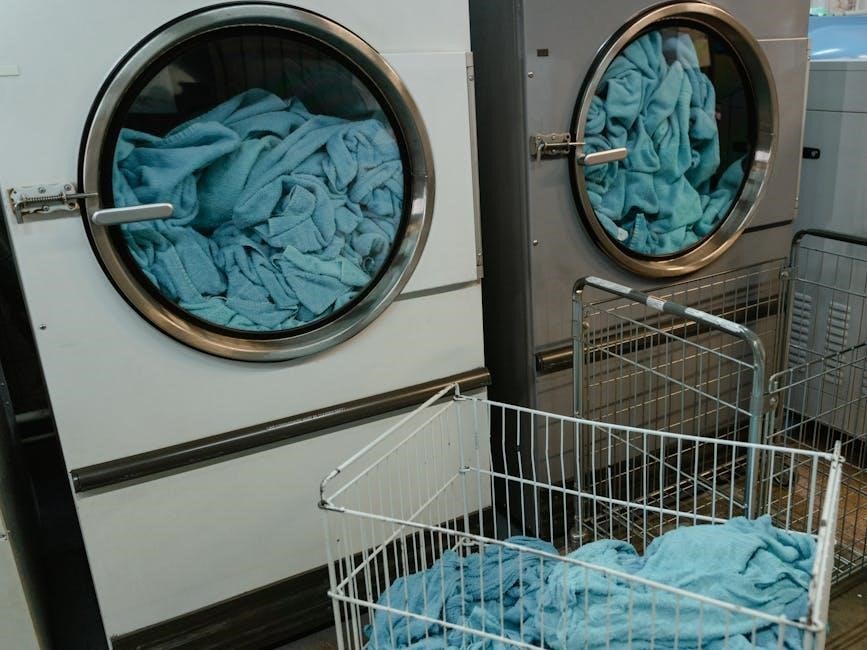
Water Level Sensor Errors in your GE washer dryer combo suggest problems with the system’s ability to detect the correct water level, leading to either insufficient or excessive water during the wash cycle. Start by inspecting the water supply lines for any kinks, blockages, or restrictions. Ensure that the water pressure is adequate and that the water inlet valves are fully open.
Next, examine the pressure hose, which connects the water level sensor to the tub. Check for any damage, cracks, or obstructions in the hose. A clogged or damaged pressure hose can prevent the sensor from accurately detecting the water level. Additionally, inspect the water level sensor itself for any signs of damage or malfunction.
Clean the drain pump filter, as a clogged filter can also affect water level detection. If the water level sensor is faulty, it may need to be replaced by a qualified technician. A simple reset by unplugging the appliance can sometimes resolve the issue if it’s due to a temporary glitch. If the error persists, further diagnostics may be necessary.
Addressing Locked Rotor Errors
Addressing Locked Rotor Errors in your GE washer dryer combo requires a systematic approach to identify and resolve the underlying cause. This error typically indicates that the motor is jammed or encountering excessive resistance, preventing the drum from spinning properly. Start by ensuring the load inside the drum is balanced and not excessively heavy. An unbalanced load can put undue strain on the motor, leading to a locked rotor error.
Next, carefully inspect the drum for any foreign objects that may be obstructing its movement. Items such as clothing, coins, or small objects can become lodged between the drum and the outer tub, causing the rotor to lock up. If you suspect a foreign object, try manually rotating the drum to see if you can dislodge it.
If the drum is clear of obstructions and the load is balanced, the problem may lie with the motor itself or its components. Listen for any unusual noises coming from the motor area, such as grinding, squealing, or humming. These sounds could indicate a failing motor bearing or a faulty motor winding. In such cases, it’s best to consult a qualified appliance technician for diagnosis and repair.
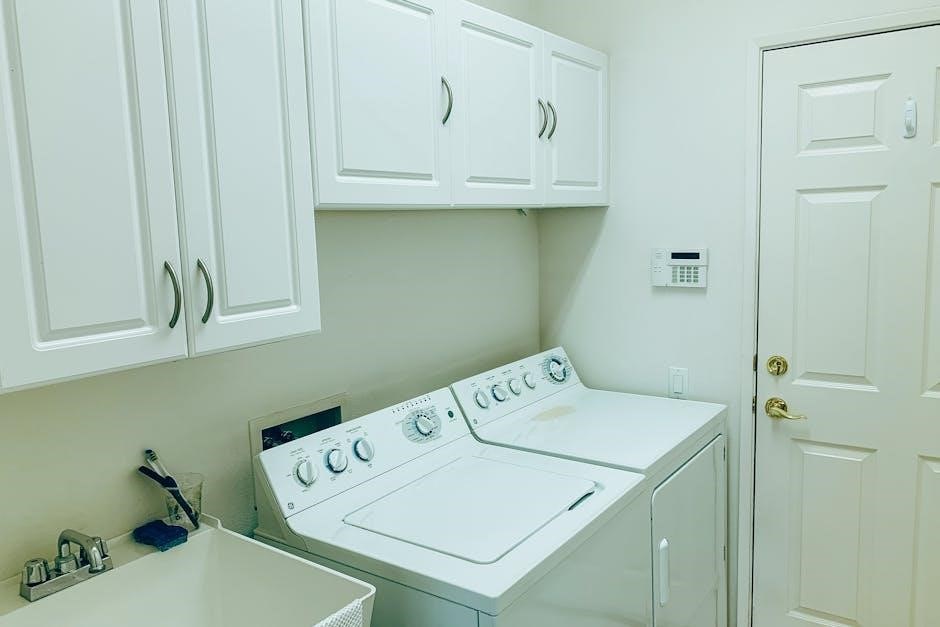
Addressing Pressure Sensor Errors
Addressing Pressure Sensor Errors in your GE washer dryer combo involves checking the components related to water pressure regulation within the appliance. This error often indicates a problem with the system’s ability to accurately monitor water pressure during the filling and draining cycles. Begin by inspecting the pressure hose, a small tube that connects the pressure sensor to the wash tub. Ensure that this hose is not kinked, pinched, or obstructed in any way. A blocked or damaged pressure hose can prevent the sensor from receiving accurate pressure readings.
Next, examine the pressure sensor itself. This sensor is responsible for converting water pressure into an electrical signal that the control board can interpret. Look for any signs of damage or corrosion on the sensor. If the sensor appears to be faulty, it may need to be replaced. However, before replacing the sensor, it’s a good idea to test it with a multimeter to verify that it’s actually malfunctioning.
If the pressure hose and sensor appear to be in good condition, the problem may lie with the water inlet valve or the drain pump. A malfunctioning water inlet valve can cause erratic water pressure, while a clogged drain pump can prevent the tub from draining properly, leading to pressure sensor errors. Check these components for any signs of damage or blockage, and replace them if necessary.
Performing a System Reset
A system reset on your GE washer dryer combo can often resolve minor software glitches or temporary errors that may be causing error codes to appear. Before attempting any more complex troubleshooting steps, performing a reset is a good first step to try. The simplest method involves disconnecting the appliance from its power source. Locate the power cord and unplug it from the electrical outlet. It’s crucial to leave the unit unplugged for a sufficient amount of time, typically at least one minute, to allow the internal components to fully discharge.
This complete power interruption clears any temporary data stored in the control board’s memory. After waiting for the specified time, plug the power cord back into the outlet. Powering the appliance back on initiates a system reboot, which can sometimes resolve minor software-related issues. Some GE washer dryer combo models may also feature a dedicated “Reset” button on the control panel. If your model has this button, consult your user manual for specific instructions on how to use it.
The manual will outline the correct procedure, which usually involves pressing and holding the “Reset” button for a certain duration. Once the reset is complete, run a test cycle to see if the error code has been cleared. If the error persists after the reset, it may indicate a more serious underlying problem that requires further investigation.
Advanced Diagnostics and Error Code Interpretation
When a simple system reset fails to resolve the error codes displayed on your GE washer dryer combo, it’s time to delve into more advanced diagnostic procedures. Many GE models have built-in diagnostic modes accessible through specific button combinations, providing deeper insights into potential malfunctions. Consult your appliance’s user manual to find the precise sequence to enter this diagnostic mode. It typically involves pressing and holding a combination of buttons for a specified duration. Once activated, the appliance may display internal error codes not visible during normal operation.
These advanced codes offer more specific clues about the nature of the problem, often pinpointing the exact component or system that’s malfunctioning. However, interpreting these codes requires a deeper understanding of appliance mechanics. Online resources, including GE’s official website and appliance repair forums, can be invaluable in deciphering these advanced diagnostic codes and understanding their implications. Some diagnostic tests may require specialized tools or expertise, so proceed with caution.
Improperly interpreting or attempting to fix complex issues can lead to further damage. If you’re not comfortable working with internal appliance components, it’s best to call a qualified technician. They possess the knowledge and tools to safely diagnose and repair intricate problems, ensuring the proper functioning of your GE washer dryer combo. Remember, safety should always be your top priority when dealing with appliance repairs.

Identifying and Replacing Faulty Components
Once advanced diagnostics pinpoint a faulty component within your GE washer dryer combo, accurately identifying and replacing it becomes crucial for restoring functionality. Begin by consulting your appliance’s user manual or a readily available parts diagram. These resources often provide detailed schematics illustrating the location and function of each part, helping you efficiently locate the malfunctioning component and avoid unnecessary disassembly. Carefully note the part’s model number to ensure you order an exact replacement. Numerous online retailers specialize in appliance parts, offering convenient access and often competitive pricing. When ordering, double-check the part’s compatibility with your specific GE washer dryer combo model.
Replacing parts typically requires basic hand tools and some technical aptitude. Always disconnect the power supply before undertaking any repairs to prevent electrical shocks. Carefully follow the instructions provided in your manual or found in online repair guides. If you are unsure about any step, it’s wise to seek professional assistance to avoid further damage to your appliance. Improper installation could void any warranties and potentially create safety hazards. After replacing the part, carefully reassemble the appliance and thoroughly test its functionality to verify the repair’s success.
Preventative Maintenance for Error Code Reduction
Regular preventative maintenance significantly extends the lifespan of your GE washer dryer combo and minimizes the likelihood of encountering error codes. Begin by consistently cleaning the lint filter after each drying cycle. A clogged filter restricts airflow, reducing drying efficiency and potentially causing overheating, which can trigger error codes. Inspect the pump filter periodically, removing any accumulated debris or blockages. This simple step prevents clogs and ensures efficient water drainage, a critical factor in preventing water-related errors. Check and clean the water inlet hoses regularly to remove mineral deposits or sediment that can impede water flow and cause error codes related to water levels and filling issues.
A yearly inspection of the hoses for wear and tear is also recommended, replacing them if necessary to avoid leaks that can trigger error codes. Consider using a washing machine cleaner periodically to remove detergent buildup and mineral deposits that may accumulate within the machine’s drum and internal components. Leveling your appliance is crucial; an unbalanced machine can cause excessive vibration and potential damage, contributing to various error codes. Regularly inspect the door seals for wear and tear; damaged seals can lead to leaks and inefficient operation.

Model-Specific Error Code Variations
GE produces a wide range of washer dryer combo models, each with its own unique set of error codes, demanding careful attention. While some codes are universal across GE models, others are specific to certain machines, reflecting internal component and control system variations. Understanding these model-specific nuances is crucial for accurate troubleshooting, ensuring the right corrective actions are taken. The model number, typically found on a sticker inside the door or on the back of the appliance, is key to identifying the correct error code meanings, unlocking access to specialized information.
GE’s official website and online manuals often provide detailed error code lists specific to individual models. These resources can be invaluable in deciphering the meaning of a displayed error code and guiding you through appropriate troubleshooting steps tailored to your machine. Popular models like the GTUP270EM0WW, GTUP270EM1WW, and others within the GUD and WSM series often have their own unique code sets, reflecting variations in internal components and control systems. Online forums and communities dedicated to GE appliances may also offer insights into model-specific error code experiences from other users.
Locating Your GE Washer Dryer Combo Model Number
Locating your GE washer dryer combo’s model number is the first crucial step in troubleshooting error codes, unlocking access to specific information. This number, usually a combination of letters and numbers, acts as a unique identifier for your specific appliance model, enabling targeted assistance. It’s typically found on a sticker affixed to the inside of the door, the back of the machine, or sometimes on the top panel, offering convenient access. Take note of this number carefully; it’s essential for accessing relevant documentation and support resources.
Once you’ve located the model number, use it to find the corresponding user manual, a key resource for troubleshooting. GE provides online access to user manuals for many of its appliance models, streamlining the process. Their official website usually has a section dedicated to support and documentation, allowing for easy searching and retrieval. Inputting your model number into the GE support website will provide access to detailed error code lists and troubleshooting guides, empowering you to address issues effectively.
